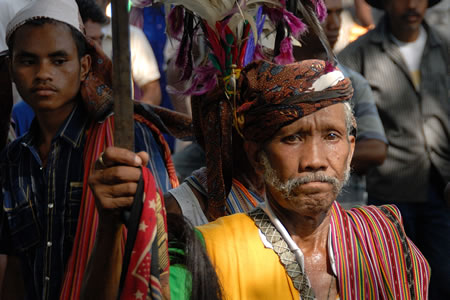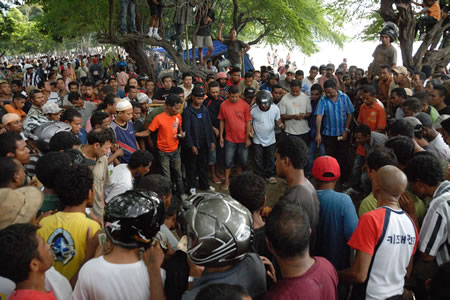English | Dutch |
|
| Independence Day in Timor-Leste | |
Dili (Timor-Leste), May 21st 2009 |
|
Timor-Leste (East Timor) is still a very young country in the South-Eastern part of Asia. After a long and bloody fight of more than twenty-five years, independency was finally reached on May 20th 2002. From 1975 onwards, when the Portuguese left the colony of East Timor in haste after the dictatorial regime in Portugal fell, Indonesia tried to incorporate East Timor as the 27th province in the Indonesian Republic. It even got the approval of powerful states like the United States and neighbouring Australia. But the people of Timor-Leste wanted to be independent after many years of Portuguese exploitation and it had to fight more than twenty-five years against the brute occupation of the Indonesian army. The firmness of the people of Timor-Leste in combination with the willingness to make sacrifices in the form of many deaths brought the independence to this small but proud country in 2002. On the morning of Independence Day, we get up early to miss nothing of the celebrations. When we arrive at the parliament building, located in the heart of the capital city Dili, it is already very busy with people. The square in front of the parliament is set off by the United Nations Police force to prevent that the common people can enter the square. On the square, different groups of the people of Timor-Leste are represented, like the army, different tribes from the hills, students and even the nuns. The common people gathered around the square and try to find as much as possible the protection of the big trees. It is still early in the morning, but the sun is already burning, making shade a necessity. Some of the students that are lined up on the square to be part of the celebrations are becoming unwell because of the heat and are brought by people of the Red Cross to cooler places. After half hour of waiting, the parade starts. The president of Timor-Leste, José Ramos-Horta, arrives on the square in an open army jeep and is driven around on the square. But the authorities are still afraid to bring him too close to the common people. And that is understandable if you know that enemies tried to assassinate him in 2008. He only just survived the attack. After the short parade, the flag of Timor-Leste is raised while the national anthem is played. |
|
 |
|
Traditional cloths at the independence celebrations in Dili |
|
After the official opening of Independence Day, we leave the central square area and walk to the ‘International People’s Park’ that is located along the bay on where Dili is situated. Many Timorese people escaped the heat and found a cooler environment near the sea and in the shade of the beautiful old trees of the park. Real festivities are not organised by the government, but the fact that many people are in the park, makes it a lively environment. There are hill tribes from different areas in the country making music and dancing about. The women are walking in circles while making whipping up rhythms, while the men in beautiful traditional dresses are dancing around the women. It is easy to see that the dresses are simple, but very traditional. The hats are self-made and decorated with feathers. To us, it looks if like they are walking around with feather brushes on their heads. The cloths are old and diverse, but it still looks like one unity. The men are dancing, making great moves while they swing their swords in the air. They are constantly laughing, making it easy to see that their teeth, as far as they are still there, never saw a dentist. Once in a while, the mainly old men are taking a short break, but it never takes more than a minute. After enjoying the music and dancing for more than an hour, we move on to another part of the park. We see men standing here and there with a cock in their hands. They cocks are treated like their little babies and that is because the cocks are a possible key to potentially a lot of money. Other men are walking around, observing the cocks carefully so that they can decide on what cock they are going to bet in the cockfights of the afternoon. Further on in the park, a football tournament for the youth is going on. The boys of ten to twelve years old are not playing on a green meadow, but on an uneven and rocky sand plain. But the fanaticism is huge. They are playing like if they know that one of the scouts of Barcelona is present to look for new talents. When one of the teams is granted with a penalty kick, the chaos is complete. The spectators are entering the playfield in search for a good spot to watch the penalty kick. Even children on their small bicycles are showing up in the goal area. The referee and the linesmen have a hell of a job to get everybody of the field again. All the pressure is too much for the young football player who needs to take the penalty; he misses. | |
 |
|
Cock fighting is very popular in Timor-Leste |
|
| In the afternoon we walk to the area where the cockfighting is organised. A little arena of approximately five by five metres is made in where the cockfights take place. But this wouldn’t be Timor-Leste if not a lot of people are standing in the arena, making it difficult for most people to see what is going on. Many men found a place in one of the trees surrounding the arena to improve their views. When two men with their cocks enter the little area, the tension increases. The betting starts and bills of ten and twenty US-dollars change hands quickly. Both cocks have a razor-sharp little knife attached to one of their legs. The cock who is able to fatally injure his opponent as first, wins the fight. When everybody made their bet, the protection of the razor-sharp little knives is removed and the fight can begin. The cocks are stirred up, and as soon as they are released they start fighting. Most of the fights only take ten to twenty seconds after which one of the cocks is deadly injured. If he is still not completely dead, his boss helps him by twisting his neck. The paying out can start. Some men make huge profits, while others leave the area disillusioned. It is also a bad day for the guy who lost the fight. He did not only lose his cock, but he also has to tell his wife that he gambled away the so important family money.
After our dinner, we go back to the square in front of the parliament to witness the closing ceremony. In contrast to the opening ceremony, the common people are now allowed to enter the square, making it possible to approach the president José Ramos-Horta and prime-minister Xanana Gusmão, who both played an important role in the independence struggle, to only tens of metres. During the playing of the national anthem, the flag is lowered, folded and afterwards given to the president. After the official festivities, it is time for the music concert that the government organised on the central square. We first have to listen for more than half an hour to two local presenters who really think they are great, after which the first act starts. Many people gathered on the square in anticipation of the artists. The first band plays two songs and at the moment they finished their second song and are waiting for cheering and applause, it stays stock-still. The listeners are not impressed at all or are not used to how to behave during a pop concert. The band leaves the stage disillusioned and is replaced by a Japanese woman in a blue gala dress. She is flown over from Japan to entertain the Timorese. As soon as she sings her first notes, we conclude that she is an opera singer but also hear that the Timorese listeners are not used to this kind of music yet. The spectators that were stock-still a couple of minutes ago, start jeering. Some are laughing while others are trying to imitate the singing of the Japanese lady. The opera singer seems not to be distracted too much and finishes her song. At the end, she even gets a mild applause and that is more than the local rock band got ten minutes ago. We see some more acts and around ten o’clock in the evening we go back to our hotel. A nice and exciting day comes to an end. Timor-Leste celebrated today her 7th anniversary. Congratulations! | |